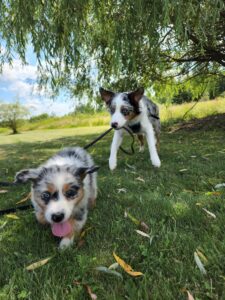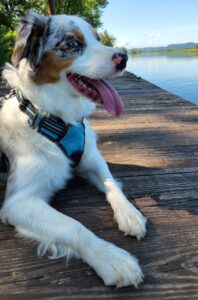A Brief History of Service Dogs
For thousands of years, dogs have served humans as guardians, military partners, and livestock herders. However, their role in assisting individuals with disabilities is a relatively recent development. Historically, pet dogs were not permitted in public places, making it a challenge to convince society of the necessity and value of service dogs. Concerns about potential risks or disturbances led to the establishment of high behavioral standards, ensuring these dogs would be recognized as essential, rather than as nuisances. The goal was to prevent any backlash that could restrict their access to public spaces.
In 1990, the Americans with Disabilities Act (ADA) officially defined an assistance animal as “any guide dog, signal dog, or other animal individually trained to provide assistance to an individual with a disability.” Since then, service dogs have become a common sight in public. However, this visibility has led some people to fraudulently pass off pet dogs as service animals to gain special privileges. This undermines the efforts of early advocates who fought for service dog access. If service dog standards decline, laws may change, and public perception could shift negatively. A few bad experiences with untrained dogs can cause business owners to question the legitimacy of all service dogs.
Understanding Public Access Laws
Taking a service dog into public spaces comes with legal responsibilities under the ADA. It is essential for service dog handlers to know and adhere to these laws, as well as be prepared to educate others when necessary. While this article focuses on U.S. laws, individual states may have additional regulations. The Supremacy Clause in Article VI of the U.S. Constitution establishes that federal law prevails over state law if conflicts arise.
Under Title II and III of the ADA, a service dog is defined as a dog trained to perform specific tasks for a person with a disability. Two key requirements must be met:
- The handler must have a qualifying disability.
- The dog must be specifically trained to perform tasks related to that disability.
Service dogs function as medical equipment or assistive technology, performing tasks that their handlers cannot do on their own. Unlike pets, service dogs undergo specialized training to provide reliable, on-command assistance. A pet dog that occasionally exhibits helpful behaviors, such as licking a handler’s face or reacting to glucose changes, does not qualify as a service dog unless those behaviors are trained responses.
For an extensive list of service dog tasks, visit the International Association of Assistance Dog Partners (IAADP) website at iaadp.org/tasks.html.
Where Can You Take Your Service Dog?
A fully trained service dog has the right to accompany its handler in any area open to the public, including businesses, government buildings, and nonprofit organizations. Some key considerations include:
- Restaurants: Service dogs may sit with their handlers in dining areas but may be restricted from kitchens, which are not open to the public.
- Hospitals: Service dogs can accompany handlers in patient rooms, clinics, examination rooms, and cafeterias, but not in sterile environments like operating rooms.
- Emergency Situations: If an individual requires ambulance transport, their service dog is permitted to accompany them unless space limitations or medical interventions prevent it.
- Religious Institutions & Private Clubs: These entities are exempt from ADA laws and may refuse entry to service dogs.
- Schools: Elementary, middle, and high schools must accommodate service dogs, but students must be able to manage their dogs, and schools must provide appropriate facilities for the dog’s needs.
- Workplaces: Under Title I of the ADA, employers must make “reasonable accommodations” for service dogs, as long as they do not create undue hardship or pose a safety risk. Examples include modifying “No Pets” policies and adjusting work schedules for employees with dog allergies.
Businesses cannot charge additional fees for service dogs, refuse service, or segregate handlers. Hotels, airlines, and restaurants must treat service dog teams the same as other patrons.
When Can a Business Restrict or Exclude a Service Dog?
Although the ADA protects service dogs, there are limited circumstances where a business or organization can deny access:
- If the dog is out of control and the handler does not take action to correct its behavior.
- If the dog is not house-trained and has accidents in public spaces.
- If allowing the dog would fundamentally alter the nature of the business or service (e.g., bringing a dog into a dormitory reserved for people with severe allergies).
- If the dog’s presence would cause distress or pose a safety risk, such as in certain zoo exhibits where animals may react aggressively.
A service dog must always be under the handler’s control, either on a leash or through verbal/hand signals if a leash interferes with task performance. A single bark due to provocation or surprise does not constitute loss of control if the dog settles quickly.
Proving Your Dog is a Service Dog
In the U.S., business owners and employees can only ask two questions if they doubt a dog’s legitimacy:
- Is the dog a service animal required because of a disability?
- What task(s) has the dog been trained to perform?
They cannot require documentation, demand medical proof, or insist the dog wear an ID or vest. However, using a clearly marked vest is highly recommended to prevent confusion in public settings. Online service dog certifications or registries are not legally recognized, despite their professional appearance.
For more information, visit ada.gov/service_animals_2010.htm.
Maintaining Rights and Responsibilities
The ADA grants people with disabilities the right to have their service dog with them in public, as long as the dog does not create a disturbance. However, it is crucial to uphold high standards of behavior to protect these rights. Historically, service dogs were not always welcome in public spaces, and the laws that allow them access today could change if handlers do not uphold responsible ownership. By maintaining professionalism and respect for others, service dog teams help preserve these hard-won rights for future generations.








